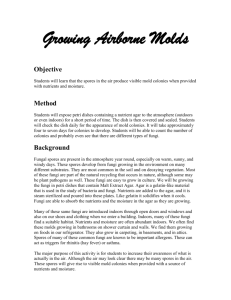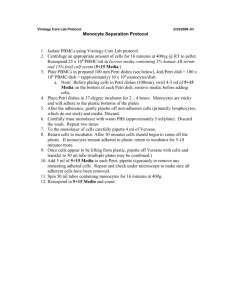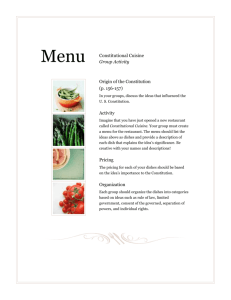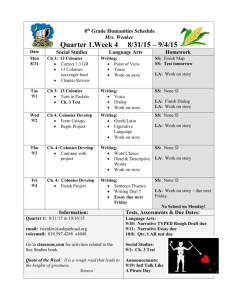D:\MyFiles\Instructions\air test mold or bacteria\air test instructions
advertisement
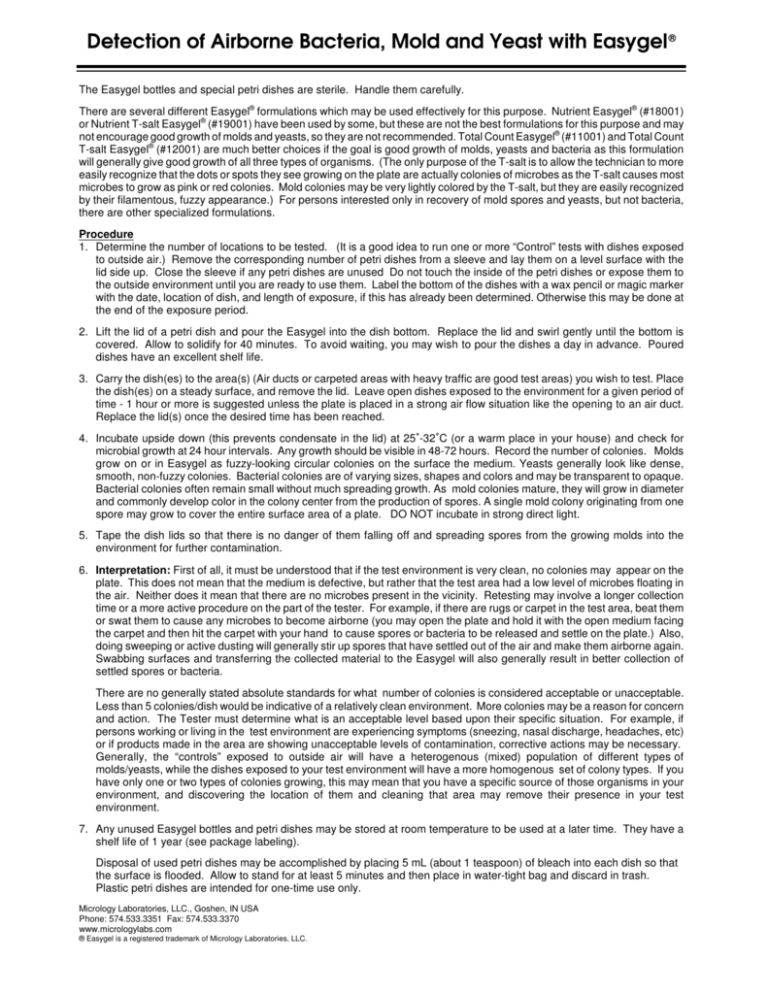
Detection of Airborne Bacteria, Mold and Yeast with Easygel ® The Easygel bottles and special petri dishes are sterile. Handle them carefully. There are several different Easygel® formulations which may be used effectively for this purpose. Nutrient Easygel® (#18001) or Nutrient T-salt Easygel® (#19001) have been used by some, but these are not the best formulations for this purpose and may not encourage good growth of molds and yeasts, so they are not recommended. Total Count Easygel® (#11001) and Total Count T-salt Easygel® (#12001) are much better choices if the goal is good growth of molds, yeasts and bacteria as this formulation will generally give good growth of all three types of organisms. (The only purpose of the T-salt is to allow the technician to more easily recognize that the dots or spots they see growing on the plate are actually colonies of microbes as the T-salt causes most microbes to grow as pink or red colonies. Mold colonies may be very lightly colored by the T-salt, but they are easily recognized by their filamentous, fuzzy appearance.) For persons interested only in recovery of mold spores and yeasts, but not bacteria, there are other specialized formulations. Procedure 1. Determine the number of locations to be tested. (It is a good idea to run one or more “Control” tests with dishes exposed to outside air.) Remove the corresponding number of petri dishes from a sleeve and lay them on a level surface with the lid side up. Close the sleeve if any petri dishes are unused Do not touch the inside of the petri dishes or expose them to the outside environment until you are ready to use them. Label the bottom of the dishes with a wax pencil or magic marker with the date, location of dish, and length of exposure, if this has already been determined. Otherwise this may be done at the end of the exposure period. 2. Lift the lid of a petri dish and pour the Easygel into the dish bottom. Replace the lid and swirl gently until the bottom is covered. Allow to solidify for 40 minutes. To avoid waiting, you may wish to pour the dishes a day in advance. Poured dishes have an excellent shelf life. 3. Carry the dish(es) to the area(s) (Air ducts or carpeted areas with heavy traffic are good test areas) you wish to test. Place the dish(es) on a steady surface, and remove the lid. Leave open dishes exposed to the environment for a given period of time - 1 hour or more is suggested unless the plate is placed in a strong air flow situation like the opening to an air duct. Replace the lid(s) once the desired time has been reached. 4. Incubate upside down (this prevents condensate in the lid) at 25 -32 C (or a warm place in your house) and check for microbial growth at 24 hour intervals. Any growth should be visible in 48-72 hours. Record the number of colonies. Molds grow on or in Easygel as fuzzy-looking circular colonies on the surface the medium. Yeasts generally look like dense, smooth, non-fuzzy colonies. Bacterial colonies are of varying sizes, shapes and colors and may be transparent to opaque. Bacterial colonies often remain small without much spreading growth. As mold colonies mature, they will grow in diameter and commonly develop color in the colony center from the production of spores. A single mold colony originating from one spore may grow to cover the entire surface area of a plate. DO NOT incubate in strong direct light. 5. Tape the dish lids so that there is no danger of them falling off and spreading spores from the growing molds into the environment for further contamination. 6. Interpretation: First of all, it must be understood that if the test environment is very clean, no colonies may appear on the plate. This does not mean that the medium is defective, but rather that the test area had a low level of microbes floating in the air. Neither does it mean that there are no microbes present in the vicinity. Retesting may involve a longer collection time or a more active procedure on the part of the tester. For example, if there are rugs or carpet in the test area, beat them or swat them to cause any microbes to become airborne (you may open the plate and hold it with the open medium facing the carpet and then hit the carpet with your hand to cause spores or bacteria to be released and settle on the plate.) Also, doing sweeping or active dusting will generally stir up spores that have settled out of the air and make them airborne again. Swabbing surfaces and transferring the collected material to the Easygel will also generally result in better collection of settled spores or bacteria. There are no generally stated absolute standards for what number of colonies is considered acceptable or unacceptable. Less than 5 colonies/dish would be indicative of a relatively clean environment. More colonies may be a reason for concern and action. The Tester must determine what is an acceptable level based upon their specific situation. For example, if persons working or living in the test environment are experiencing symptoms (sneezing, nasal discharge, headaches, etc) or if products made in the area are showing unacceptable levels of contamination, corrective actions may be necessary. Generally, the “controls” exposed to outside air will have a heterogenous (mixed) population of different types of molds/yeasts, while the dishes exposed to your test environment will have a more homogenous set of colony types. If you have only one or two types of colonies growing, this may mean that you have a specific source of those organisms in your environment, and discovering the location of them and cleaning that area may remove their presence in your test environment. 7. Any unused Easygel bottles and petri dishes may be stored at room temperature to be used at a later time. They have a shelf life of 1 year (see package labeling). Disposal of used petri dishes may be accomplished by placing 5 mL (about 1 teaspoon) of bleach into each dish so that the surface is flooded. Allow to stand for at least 5 minutes and then place in water-tight bag and discard in trash. Plastic petri dishes are intended for one-time use only. Micrology Laboratories, LLC., Goshen, IN USA Phone: 574.533.3351 Fax: 574.533.3370 www.micrologylabs.com ® Easygel is a registered trademark of Micrology Laboratories, LLC.

